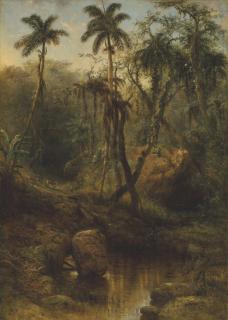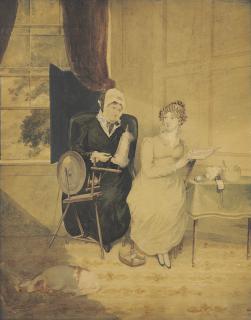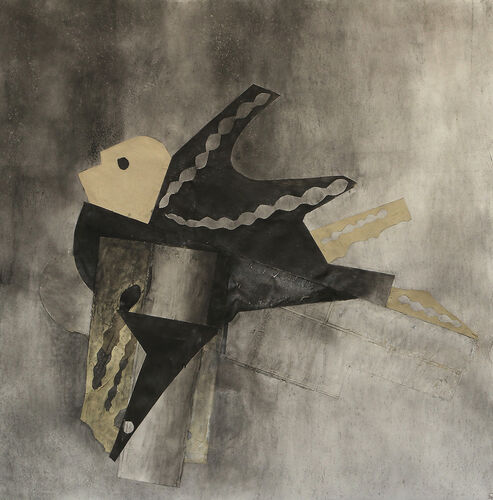- Art.Salon
- Artists
- Gerrit Carl François Schouten
- A Carib Indian Camp, Surinam – A Diorama
Gerrit Carl François Schouten
A Carib Indian Camp, Surinam – A Diorama
Found at
Christies,
London (Online Auction)
Topographical Pictures, including China Trade Paintings. ARCTIC · AMERICAS · AFRICA · ASIA · AUSTRALASIA · ANTARCTICA, Lot 32
5. Nov - 5. Nov 2020
Topographical Pictures, including China Trade Paintings. ARCTIC · AMERICAS · AFRICA · ASIA · AUSTRALASIA · ANTARCTICA, Lot 32
5. Nov - 5. Nov 2020
Estimate: 10.000 - 15.000 GBP
Price realised: 11.875 GBP
Price realised: 11.875 GBP
Description
signed and dated 'G. Schouten fecit 1818.' (on a paper label in the lower left corner)
wood, glue, painted paper and glass
19 1⁄4 x 30 3⁄4 x 9 1⁄4in. (48.9 x 78.3 x 23.5cm.)
Gerrit Schouten was born in 1799 in Paramaribo, the administrative centre of the Dutch colony of Surinam, the son of the poet Hendrick Schouten and Suzanna Johanna Hanssen, a free coloured native of Surinam. A botanical and animal painter, he is best known for over forty dioramas which describe the Dutch colony of Surinam in the early 19th century, the majority now in institutional collections in the Netherlands. Schouten was commissioned to produce two dioramas of the indigenous peoples of Suri
Schouten's dioramas range in size from 35cm. to 170cm. wide, the glazed cabinets made from Surinam hardwoods and European soft woods, including from boxes used to import goods into the colony. The models, carefully shaped to work in correct perspective, are made of paper and mounted with an animal glue. Most, as here, bear a label in the lower left corner of the case with the artist's signature.
' ... Schouten is best known today for his dioramas ... In this pre-photography era, he introduced the 'raree show' to the colony, capturing the memories of plantation owners, merchants and travellers of their property or their stay in Suriname. Made to order, these were expensive items. Some dioramas cost no less than 500 guilders, the sort of amount one might have paid for an enslaved person. Schouten was born and bred in Paramaribo and was able to live from his artistic work, and this led him
Surinam or Dutch Guyana was a flourishing plantation colony ceded to the Dutch by the British in 1667. The territory attracted the Dutch planters who had been expelled from Brazil in the mid-17th century and produced sugar on large plantations worked by slaves from West Africa through the 18th to the mid-19th century, the slaves replaced by indentured labour from India and Java after abolition in Surinam in 1863.
For a similar diorama by Schouten of an Arowak Camp, see Christie's, London, 29 Oct. 2019, lot 43.
wood, glue, painted paper and glass
19 1⁄4 x 30 3⁄4 x 9 1⁄4in. (48.9 x 78.3 x 23.5cm.)
Gerrit Schouten was born in 1799 in Paramaribo, the administrative centre of the Dutch colony of Surinam, the son of the poet Hendrick Schouten and Suzanna Johanna Hanssen, a free coloured native of Surinam. A botanical and animal painter, he is best known for over forty dioramas which describe the Dutch colony of Surinam in the early 19th century, the majority now in institutional collections in the Netherlands. Schouten was commissioned to produce two dioramas of the indigenous peoples of Suri
Schouten's dioramas range in size from 35cm. to 170cm. wide, the glazed cabinets made from Surinam hardwoods and European soft woods, including from boxes used to import goods into the colony. The models, carefully shaped to work in correct perspective, are made of paper and mounted with an animal glue. Most, as here, bear a label in the lower left corner of the case with the artist's signature.
' ... Schouten is best known today for his dioramas ... In this pre-photography era, he introduced the 'raree show' to the colony, capturing the memories of plantation owners, merchants and travellers of their property or their stay in Suriname. Made to order, these were expensive items. Some dioramas cost no less than 500 guilders, the sort of amount one might have paid for an enslaved person. Schouten was born and bred in Paramaribo and was able to live from his artistic work, and this led him
Surinam or Dutch Guyana was a flourishing plantation colony ceded to the Dutch by the British in 1667. The territory attracted the Dutch planters who had been expelled from Brazil in the mid-17th century and produced sugar on large plantations worked by slaves from West Africa through the 18th to the mid-19th century, the slaves replaced by indentured labour from India and Java after abolition in Surinam in 1863.
For a similar diorama by Schouten of an Arowak Camp, see Christie's, London, 29 Oct. 2019, lot 43.
Auction result well in line with expectations
The work A Carib Indian Camp, Surinam – A Diorama by Gerrit Carl François Schouten was sold in the Topographical Pictures, including China Trade Paintings. ARCTIC · AMERICAS · AFRICA · ASIA · AUSTRALASIA · ANTARCTICA auction at Christies in London in November 2020. The price achieved of GBP 11,875.00 (€ 13,256.51) was within expectations - the estimate range had previously been set by the auction house as GBP 10,000.00 – 15,000.00. Other works by Gerrit Carl François Schouten have already achieved higher auction prices, for example, in October 2019 the work Arowak Indian Camp, Paramaribo (Surinam) – a diorama was auctioned for GBP 16,250.00 (€ 18,848.83).
Auktionsergebnis im Rahmen der Erwartungen
Die Arbeit A Carib Indian Camp, Surinam – A Diorama von Gerrit Carl François Schouten wurde im November 2020 in der Auktion Topographical Pictures, including China Trade Paintings. ARCTIC · AMERICAS · AFRICA · ASIA · AUSTRALASIA · ANTARCTICA bei Christies in London versteigert. Der dabei erzielte Preis von GBP 11.875,00 (€ 13.256,51) lag im Rahmen der Erwartungen – die Schätzpreisspanne war von dem Auktionshaus zuvor mit GBP 10.000,00 – 15.000,00 angegeben worden. Andere Arbeiten von Gerrit Carl François Schouten konnten bereits höhere Auktionspreise erzielen, so wurde im Oktober 2019 die Arbeit Arowak Indian Camp, Paramaribo (Surinam) – a diorama für GBP 16.250,00 (€ 18.848,83) versteigert.














































